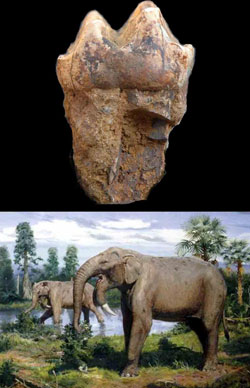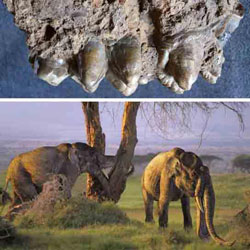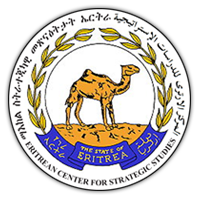September 26, 2013
Eritrea: Discovery of New Fossil
“Missing link” of elephant family unearthed in Eritrea

Deinotherium from Mai-Ghebro(Kudo-Felassi)
by Kesete Ghebrehiwet | The discovery of an ancient human fossil in Eritrea at Buya site in the Northern Red Sea region has opened a new chapter in the history of human evolution. The discovered fossil represents the Homo-erectus species that inhabited the area some million years ago. Though the oldest fossil “Madam Buya” discovered in 1997 is named after the place of discovery, the inhabitants of that respective area have given it a local name “Hawa”- meaning Eve.
This human fossil which is an almost complete skull ageing more than one million years. This initial discovery of ancient fossils is now surprisingly followed by two new discoveries of human frontal lobe and elephant fossil as well as stone tools at two geographically different parts of the country both of which were unearthed in a range of two months. Such a first of its kind discovery attest to the fact that Eritrea possessed a complete ecosystem harboring abundant animal species and earliest humans.What the new discoveries hinted is that the Eritrean Rift Valley and other sites in the highlands are endowed with rich heritages of the prehistoric period. It is a rare occasion to simultaneously find fossils and stone tools altogether at a particular spot through simple surface excavations or naturally uncovered to the earth surface through erosion.
What makes the anthropological sites of Eritrea distinct form the sites that have been discovered in the East Africa is in fact its range of content and type. The recent findings indicate traces of ancient ecology and activities of early modern humans in wider areas of the Eritrean Denakil Rift valley such as Buya, Me’abele, Diolil, Darayto, Alat and Dandero areas. Likewise, in Dalul near Massawa and the most recent highland finding of elephant fossil in Kudefelasi at Mai-Ghebro site near Mendefera in the Southern Region of Eritrea.
The fossils collected from the Kudofelassi area, which used to be a dense forest are estimated from 25-27 million year old molar of an extinct elephant species known as Deinotherium among others. Dr. Yosief Libsekal, head of the National Museum indicated that the recent finding of fossil mammals in Kudofelasi would fill the gab of missing link in the evolutionary history of such species. These findings indeed would unveil many mysteries of the history of mammals’ evolution.
According to Dr. Yosief, upon hearing report of the newly discovered fossil from Amanuel Solomon an ex-fighter who lives in Kudofelasi and earns his living in farming, a team of researches from the National Museum of Eritrea and other professionals from Italian universities of Florence and Rome have made extensive researches on the elephant fossil discovered in November 2010.
Eritrea has been gaining recognition as such findings steadily continued to grow. In the course of a recent exploration conducted in the Eritrean territorial waters, international scientists have already come up with findings that hold clues about the way of life of early modern humans.

Extinct Elephants from Mai-Ghebro near Kudo-Felassi
In a research conducted in the Northern Denkalia, at a place called Mulhuili-Amo in the environs of Me’abele, a human frontal lobe and various stone tools were discovered on 15th December 2010. This finding further attests to the promising paleontological and paleoanthropological potential of other sites that need extensive survey. The finds of the respective area of Mulhuili-Amo, Dr. Yosief emphasized, represent a very ancient prehistoric period even at a global level, which the international scientists from Italy who have been collaborating with the national Museum of Eritrea have confirmed.
Up on visiting the National museum of Eritrea one could see double-edged stone blades that were utilized for varied purposes. The stone tools recently unearthed were shaped from basalt, granite, and quartz most of the time used to drain the marrow of animals indicating the way of life of early modern humans. Dr. Yosief is appreciative of the craft of the ancient humans when he says; these stone tools indicate the skill and geometrical concept of early humans who lived in the areas. Such stones are not ordinary stones but rather strong and much convenient to carve to what ever shape one likes.
The fossil findings in the southern Region of Eritrea represent the time before the African and Arabian plates drifted apart. Mr. Tsegay Medhin, a professional in paleontology pointed out that size measurements have been taken and comparisons have been drawn between the recent elephant fossil and another similar fossil found in Dogoli in 1997. These species of Elephant is relatively closer to the present day elephant species in terms of weight and body size. Such recent finding is expected to change the knowledge of elephant evolution.
As regards to the importance of such findings Mr. Tsegay said that fossils of varied mammals in great numbers such as of rhinos, elephants, pigs, antelopes, zebras among others have been discovered in the same stratigraphy, is highly imperative in conducting research of evolution. Likewise, Dr. Yosief stated that fossils of birds, fish, turtle, and crocodile have been discovered giving rise to the variety of species. Such findings have been given local names to represent the place of discovery. For instance, Mr. Tesegay said, “an elephant fossil discovered in 1997 was named Eritrieum Melakeghebrekristosi after the name of the person who discovered it.”
Also according to Mr. Tsegay, the discovered archeological findings represent different historical eras and chronologies of prehistory, the stone ages, the marine life environments and others that stretch from 1-2 million years ago in Buya and its environs and up to 27 million years ago in the case of the Kudofelasi finding.The aforementioned discovery of diversified species in a short span of time indicates that Eritrea is endowed with much more relics of the past that are waiting to be excavated and surveyed. Such discoveries would also call for the rewriting of the records of evolutionary history of humans and other mammals.



